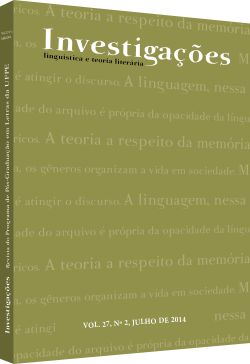A construção do sentido no discurso: um estudo de base enunciativa
Abstract
Resumo: Este estudo investiga com base especialmente em princípios saussurianos e benvenistianos a construção dos sentidos no discurso. A partir da análise de dois poemas, não só foi possível perceber que o sentido é construído no sintagma, fazendo-se improdutiva a atividade de busca aos significados dicionarizados de signos, quando se busca compreender um texto, mas também que nenhum signo pode ser substituído por outro depois de ser selecionado e transportado para o eixo sintagmático. Este estudo explicita contribuições para o ensino de língua e de literatura, permitindo qualificar atividades de produção e reescrita de textos.References
ARRIVÉ, Michel.2010. Em busca de Ferdinand de Saussure. Tradução Marcos Marcionilo. São Paulo: Parábola Editorial.
BANDEIRA, Manuel. 1970. Poesia. Rio: Livraria Agir Editora, p. 28-30.
BARROS, Manoel de. 2003. Memórias inventadas: a infância. São Paulo: Planeta.
BENVENISTE, Émile. 2005. Os níveis de análise linguística. In: ______. Problemas de lingüística geral I. Tradução de Maria da Glória Novak e Maria Luisa Neri; revisão do prof. Isaac Nicolau Salum. Campinas, SP: Pontes. Cap. 10, p. 127-140.
_____. 2006. A forma e o sentido na linguagem. In: Problemas de lingüística geral II. ______. Tradução Eduardo Guimarães et al.; revisão técnica da tradução Eduardo Guimarães. Campinas, SP: Pontes cap. 15, p. 220-242.
CÂMARA JR., J. Mattoso. 1978. Dicionário de Lingüística e Gramática. Petrópolis: Vozes.
CAVICHIOLI, Fabrícia. 2010. Relações sintagmáticas e associativas no ensino de leitura: um encontro interdisciplinar e sugestivo para a prática professoral em língua materna. Travessias, Cascavel, v. 4 , n. 2. p. 525-537.
FIORIN, José Luiz. 2011. Teoria dos signos. In: FIORIN, José Luiz (org.). Introdução à Linguística I. Objetos teóricos. São Paulo: Contexto, p. 55-74.
______. 2012. Da necessidade da distinção entre texto e discurso. In: BRAIT, Beth; SOUZA-E-SILVA, Maria Cecília (Orgs.). Texto ou discurso? São Paulo: Contexto, p. 145-162.
FLORES, Valdir do Nascimento. 2001. Princípios para a definição do objeto da lingüística da enunciação: uma introdução (primeira parte). Letras de Hoje. Porto Alegre, v. 36, n. 4, p.7-67, dez.
FLORES, Valdir Nascimento do; TEIXEIRA, Marlene. 2009. Saussure, Benveniste e a teoria do valor: do valor e do homem na língua. Letras & Letras, Uberlândia, v. 25, n. 1., p. 73-84, jan./jun.
LEROY, Mourice. 1971. As grandes correntes da linguística moderna. Tradução de Izidoro Blikstein, José Paulo Paes e Frederico Pessoa de Barros. São Paulo: Cultrix.
LOPES, Edward. 1975. Fundamentos de linguística contemporânea. São Paulo: Cultrix.
LYRA, Pedro. 1986. Conceito de poesia. Série Princípios. São Paulo: Ática.
MARTINET, André. 1978. Elementos de linguística geral. Tradução adaptada para leitores de língua portuguesa por Jorge Morais-Barbosa. Lisboa: Pontes.
MOURA, Heronides. 2007. Relações paradigmáticas e sintagmáticas na interpretação de metáforas. Linguagem em (Dis)curso, Tubarão, v. 7, n. 3, p. 417-452, set./dez.
MOUNIN, Georges. 1968. Introdução à linguística. São Paulo: Martins Fontes.
NORMAND, Claudine. 1996. Saussure-Benveniste. In: GIACOMELLI, Karina e PIRES, Vera Lúcia. (Orgs.) Émile Benveniste: interfaces, Enunciação & Discursos. Santa Maria, RS: PPGL-Editores. Trad. de Carmem Deleacil Ribeiro Nassar.
SAUSSURE, Ferdinand de. 1975. Curso de Linguística Geral. Organizado por Charles Bally e Albert Sechehaye. Tradução de Antônio Chelini, José Paulo Paes e Izidoro Blikstein. 7. ed. São Paulo: Cultrix.
Downloads
Published
How to Cite
Issue
Section
License
Copyright (c) 2015 Lauro Gomes, Ernani Cesar de Freitas

This work is licensed under a Creative Commons Attribution 4.0 International License.
Authors who publish with Revista Investigações agree to the following terms:
Authors retain copyright and grant the journal right of first publication with the work simultaneously licensed under the Creative Commons Attribution 4.0 International (CC BY 4.0) license that allows others to share the work with an acknowledgement of the work's authorship and initial publication in this journal.
Authors are able to enter into separate, additional contractual arrangements for the non-exclusive distribution of the journal's published version of the work (e.g., post it to an institutional repository or publish it in a book), with an acknowledgement of its initial publication in this journal.
You are free to:
Share — copy and redistribute the material in any medium or format for any purpose, even commercially.
Adapt — remix, transform, and build upon the material for any purpose, even commercially.
The licensor cannot revoke these freedoms as long as you follow the license terms.
Under the following terms:
Attribution — You must give appropriate credit , provide a link to the license, and indicate if changes were made . You may do so in any reasonable manner, but not in any way that suggests the licensor endorses you or your use.
No additional restrictions — You may not apply legal terms or technological measures that legally restrict others from doing anything the license permits.

